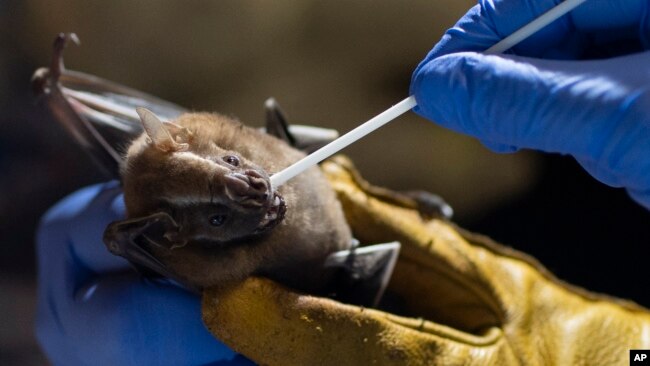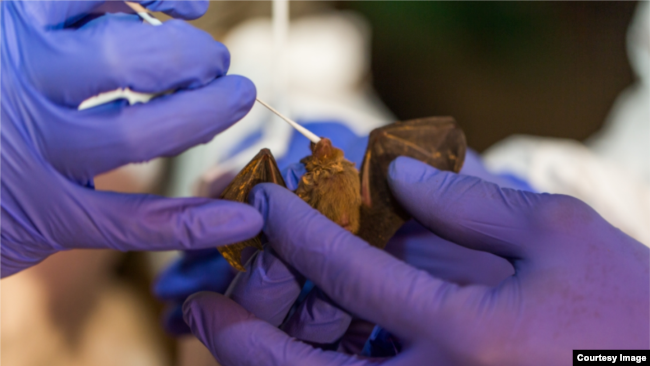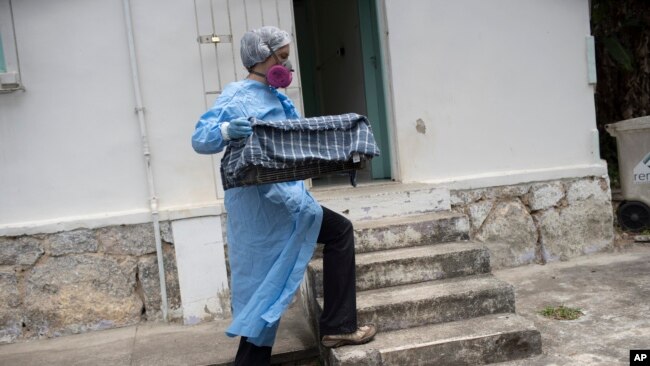注目のコウモリ研究!!!
下記を頭に入れて、Le'ts listen!!!
zoonotic diseases :人獣共通感染症
metabolism :新陳代謝
primates:霊長類
今日のVOAニュース、ミャンマーのコウモリ生息洞窟地帯の映像は必見!!
将来のパンデミックの予防を目指した新しいコウモリ研究
New Bat Studies Aim to Prevent Future Pandemics
December 20, 2020
世界中の研究者が、将来の人間のパンデミックを引き起こす可能性のある動物の集団を見つけるための努力を強めています。
その目的は、人獣共通感染症--動物から人間に感染する可能性のある病気を特定することです。
例えば、コロナウイルスは動物とヒトの両方に感染する可能性があります。米国疾病対策予防センター (CDC) は、世界の多くに影響を与える新しいもののようなコロナウイルスは、"人と多くの異なる種で一般的である "と言います。
しかし、CDC は ”稀に人に感染して人と人との間で拡散する動物性コロナウイルス" だとしています。しかし、ヒトではコロナウイルスによる大規模な疾患発生が発生しています。
コウモリがそのいくつかに関連しています。多くの科学者は、コウモリが COVID-19 という病気を引き起こす新しいコロナウイルスの最初のキャリアであると考えています。健康の専門家は、何千ものコロナウイルスがコウモリに存在していると推定していますが、その多くはまだ発見されていません。研究者たちは、新しいコロナウイルスが人間に広がるのを防ぐために、そのようなウイルスを特定しようとしています。
ガガンディープ・カン博士は、インド南部のヴェロールにあるクリスチャン・メディカル・カレッジの感染症専門家です。彼女は "もしではなくいつ”別のウイルスが動物から人間に飛び移りるか、そして早く拡散する条件を見つけることが問題なのだ、とAP通信に語っています。
カン博士は以前の研究では、インドがそのような”漏出”が起こる可能性が最も高い国の一つであることを示唆していると述べています。これは、インドでは、野生動物が生息する鬱蒼とした森林地帯に、人や家畜の個体数がますます拡大しているからです。
将来のパンデミックの予防を目的とした研究の多くは、世界で唯一の飛行哺乳類であるコウモリを中心に行われています。
南極を除く世界のすべての大陸に1,400種以上のコウモリが生息しています。その多くは、病気の有効な媒介者です。これは、病気の兆候をほとんど見せずに、人間や家畜に致命的なウイルスを運ぶことができるからである。専門家によると、感染したコウモリは、ウイルスを拡散させる能力を持っていて、長距離・遠距離を移動することができるといいます。
私のつぶやきー観光名所でもあるのですね。 ※quano:コウモリの糞 素手で拾うなんて。。。
「その秘密は、コウモリが異常な免疫システムを持っていることであり、それは飛ぶ能力に関係しています」とレイナ・プラウライト氏はAP通信に語っています。彼女は感染症の専門家であり、モンタナ州立大学でコウモリを研究しています。
プラウライト氏は、コウモリが地上に降りて飛行中に滞在するためには、膨大な量のエネルギーを必要とすると述べています。そのためには、彼らの新陳代謝を非常に高いレベルまで上げる必要があります。
プロウライト氏と他のコウモリの科学者たちは、動物の体が飛行の要求から回復するのを助けるために、時間の経過とともに変化していったと考えています。そのような変化は、ウイルスからの防御力を高めている可能性もあります。科学者たちは、コウモリの免疫システムの研究を続けて、動物がウイルスに負けてしまう原因についての理解を深めることを望んでいます。このような研究は、研究者が将来の治療法を開発するのにも役立つかもしれません。
カリフォルニア大学バークレー校の疾患生態学者であるカーラ・ブルック氏。彼女によると、コウモリやウイルスを運ぶ他の動物が必ずしも人間にリスクをもたらすわけではないといいます。漏出が発生するためには、適切な条件が存在しなければなりません。「我々が感染するためにはウイルスが宿主から出てこなければなりません。」とブルック氏は言います。
しかし、特に森林地域では世界的に生息地が縮小し、破壊されているため、意味することは「野生生物と人間の接触率が高くなっている」と付け加えています。このような接触は、より多くの漏出を生む可能性を秘めています。
ブラジルでは、国営のフィオクルス研究所がリオデジャネイロのペドラブランカ公園にコウモリの調査チームを派遣しました。この公園が選ばれたのは、野生動物と周辺のコミュニティに住む何千人もの人間との間に多くの交流があるからです。
科学者たちが研究しているのはコウモリだけではありません。小型の霊長類、野生の猫、COVID-19の感染が確認された家庭で飼われている猫も研究しています。
ブラジルのチームは、今世紀の第二のパンデミックのリスクを減らすことを目指している世界中の多くのチームの一つに過ぎません。
イアン・マッケイ氏は、オーストラリアのクイーンズランド大学のウイルス専門家です。彼は、科学者と政府は、いつ、どこで始まるかの迅速なメッセージング(情報受信・伝達システム)を持っていれば、将来の流行を封じ込めるためのより良いチャンスに立つだろうとAPに語っています。
※messaging【mes·ə·dʒɪŋ】
マッケイ氏 は、継続的な即時の“surveillance”監視システム - 世界保健機関(WHO)によって世界中に設置されたインフルエンザ研究室のような - は、研究者がより良い準備をするのを助けることができると述べています。彼はまた、研究室が継続的に新しい発生を発見するために病院からの廃水や材料をテストすることができることを示唆しています。
ミャンマーのコウモリの糞販売
パアケ僧院(バットケーブを所有する寺)の門前にある、何の変哲もないこの家。ここが実は、洞窟内のグアノを採取、販売している問屋だったのだ。
グアノの収穫は年に1回、収穫の権利は入札で決まるとのこと。また、バットケーブのコウモリの頭数は400万頭いるらしいとのことだった。
値段は一袋約1,600円。30kgくらいあるかな? 日本のホームセンターなどで売っている化成肥料の価格に近く、ミャンマーの農家にとってはかなりの負担感だと思う。
ー上記リンクより
コウモリの排泄物は肥料
タイの首都バンコクから西に約60マイル(約97キロ)離れたラチャブリ県では毎週土曜日の朝、コウモリが住む洞窟に10人余りの村人が入って行く。貴重なコウモリの排泄物をかき集めるためだ。
アジアやミクロネシアでは、野生のコウモリの肉が市場で販売されたり、家庭で調理されたりすることもある。コウモリ肉の消費はまれで特定の地域社会に限られるが、他の哺乳類が比較的少ないインドネシアの一部地域や太平洋の島国パラオでは地元の珍味と考えられている。
タイで感染が35件報告された後も、洞窟でコウモリの排泄物を採取する人々にとって新型コロナウイルスは最大の懸念にはなっていない。「われわれは長年、何世代にもわたりこうしてきた」とこのビジネスを管理するシンハー・シティクル氏は話す。 コウモリはラチャブリ県では貴重な生物と受け止められている。肥料の原料になるだけではなく、授粉や害虫駆除の役割もあることから、コウモリの洞窟は保護され禁猟区域とされている。
ー上記リンクより
New Bat Studies Aim to Prevent Future Pandemics
 A researcher for Brazil's state-run Fiocruz Institute takes an oral swab sample from a bat captured in the Atlantic Forest, at Pedra Branca state park, near Rio de Janeiro, Tuesday, Nov. 17, 2020. (AP Photo/Silvia Izquierdo)
A researcher for Brazil's state-run Fiocruz Institute takes an oral swab sample from a bat captured in the Atlantic Forest, at Pedra Branca state park, near Rio de Janeiro, Tuesday, Nov. 17, 2020. (AP Photo/Silvia Izquierdo)
Researchers from around the world are increasing efforts to find animal populations that could start future human pandemics.
The aim is to identify zoonotic diseases -- those that can spread from animals to humans.
Coronaviruses, for example, can infect both animals and humans. The U.S. Centers for Disease Control and prevention (CDC) says coronaviruses, like the new one affecting much of the world, “are common in people and many different species.”
But, the CDC notes, “animal coronaviruses rarely infect people and then spread between people.” There have, however, been major disease outbreaks caused by coronaviruses in humans.
Bats have been linked to some of them. Many scientists believe bats were the first carriers of the new coronavirus, which causes the disease COVID-19. Health experts estimate that thousands of coronaviruses are present in bats, with many still undiscovered. Researchers are seeking to identify such viruses in order to stop new ones from spreading to humans.
Dr. Gagandeep Kang is an infectious diseases expert at Christian Medical College, Vellore in southern India. She told The Associated Press (AP) “it’s not a question of if, but when” another virus will jump from animal to human and find the conditions to spread quickly.
Kang said earlier research has suggested that India is among the most likely countries for such a “spillover” event to happen. This is because India has seen its human and livestock populations increasingly expand into dense forest areas where wild animals live.
Much of the research aimed at preventing future pandemics has centered on bats, the world’s only flying mammals.
More than 1,400 different bat species live on every continent of the world except Antarctica. Many of them are effective carriers of disease. This is because the animals can carry viruses that are deadly in humans and livestock, while showing little signs of disease themselves. Experts say this permits infected bats to travel long and far, with the ability to spread viruses.
“The secret is that bats have unusual immune systems, and that’s related to their ability to fly,” Raina Plowright told the AP. She is an expert in infectious diseases and studies bats at Montana State University.
Plowright said bats require a huge amount of energy to get off the ground and stay in flight. To do this, their metabolism is raised to a very high level.
Plowright and other bat scientists think the animals’ bodies went through changes over time to help them recover from the demands of flying. Such changes could also give them extra protection against viruses. Scientists hope to keep studying the bat immune system to help them understand more about what makes the animals lose viruses. Such studies might also help researchers develop future medical treatments.
Cara Brook is a disease ecologist at the University of California, Berkeley. She said bats and other animals that carry viruses do not necessarily present a risk to humans. The right conditions have to exist for a spillover event to happen. “The virus has to come out of the host for us to get infected,” Brook said.
However, she added that the shrinking and destruction of habitats worldwide - especially in forested areas - means “we are seeing higher rates of contact between wildlife and humans.” Such contact creates more chances for spillover.
In Brazil, the state-run Fiocruz Institute sent teams to research bats in Rio de Janeiro’s Pedra Branca park, one of the world’s largest forests within a highly populated area. The park was chosen because it offers many interactions between wild animals and thousands of humans living in surrounding communities.
The scientists are not only studying bats. They are also studying small primates, wild cats and cats kept in homes with confirmed COVID-19 cases.
The Brazilian team is just one of many worldwide seeking to reduce the risk of a second pandemic this century.
Ian Mackay is a virus expert at Australia’s University of Queensland. He told the AP that scientists and governments would stand a better chance at containing future outbreaks if they had faster messaging of when and where they begin.
Mackay said ongoing, immediate, “surveillance” systems – like flu labs set up by the World Health Organization worldwide – could help researchers be better prepared. He also suggested that labs could continually test wastewater or materials from hospitals to discover new outbreaks.


